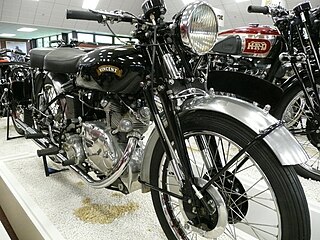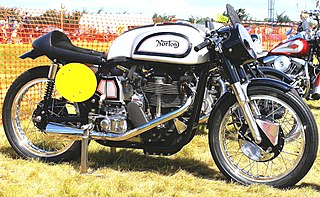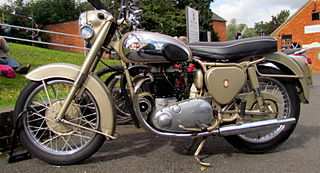
The Norton Motorcycle Company is a brand of motorcycles, originally based in Birmingham, England. This company is owned by Indian multinational giant TVS Motor Company. For some years around 1990, the rights to use the name on motorcycles was owned by North American financiers. From 2008 to 2020, a line of motorcycles was produced under owner and chief executive Stuart Garner. Due to financial failure with large debts, in April 2020 administrators BDO agreed to sell certain aspects of Garner's business to Project 303 Bidco Limited, a new business established for the purpose with links to Indian motorcycle producer TVS Motor Company.

A. J. Stevens & Co. Ltd was a British automobile and motorcycle manufacturer in operation from 1909 to 1931. The company was founded by Joe Stevens in Wolverhampton, England. After the firm was sold, the name continued to be used by Matchless, Associated Motorcycles and Norton-Villiers on four-stroke motorcycles till 1969, and since the name's resale in 1974, on lightweight, two-stroke scramblers and today on small-capacity roadsters and cruisers. The company held 117 motorcycle world records.

MV Agusta is a motorcycle manufacturer founded by Count Domenico Agusta on 19 January 1945 as one of the branches of the Agusta aircraft company near Milan in Cascina Costa, Italy. The abbreviation MV stands for Meccanica (mechanics) Verghera, the hamlet where the first MVs were made. The modern headquarters and main production facilities are located in Varese, Italy on the shore of Lake Varese.

Vincent Motorcycles was a British manufacturer of motorcycles from 1928 to 1955. The business was established by Philip Vincent who bought an existing manufacturing name HRD, initially renaming it as Vincent HRD, producing his own motorcycles as HRD did previously with engines purchased as complete assemblies from other companies. From 1934, two new engines were developed as single cylinder in 500 cc and v-twin 1,000 cc capacities. Production grew from 1936, with the most-famous models being developed from the original designs after the War period in the late 1940s.

The Cotton Motor Company, was a British motorcycle manufacturer of 11a Bristol Road, Gloucester, and was founded by Frank Willoughby Cotton in 1918. F.W. presided over the company until his retirement in 1953. The company was reconstituted as E. Cotton (Motorcycles) Ltd, and traded until 1980. The marque was later resurrected in the late 1990s by a business which manufactured replicas of earlier machines.

The BSA Gold Star is a motorcycle made by BSA from 1938 to 1963. They were 350 cc and 500 cc single-cylinder four-stroke production motorcycles known for being among the fastest bikes of the 1950s. Being hand built and with many optional performance modifications available, each motorcycle came from the factory with documented dynamometer test results, allowing the new owner to see the horsepower (bhp) produced.
Robert Leslie (Les) Graham was a British motorcycle road racer who competed in the 1930s and 1940s. He won the inaugural Grand Prix motorcycle racing 500 cc World Championship in 1949.

The Vincent Comet was designed and built at the Vincent works in Great North Road, Stevenage, Hertfordshire, England. It was one of four 499 cc single models. As well as the sports Comet, Vincent produced a TT racing model, the Comet Special and the standard Vincent Meteor which shared many of the same cycle parts.

The Norton Manx or Manx Norton is a British racing motorcycle that was made from 1947 to 1962 by Norton Motors Ltd. Norton had contested every Isle of Man TT race from the inaugural 1907 event through into the 1970s, a feat unrivalled by any other manufacturer, and the development and honing of the Manx racing motorcycle was another step in this racing achievement.

The Norton International or Cammy Norton is a Norton Motors Ltd overhead cam (OHC) motorcycle built between 1931 and 1957.

The featherbed frame was a motorcycle frame invented by the McCandless brothers and offered to the British Norton motorcycle company to improve the performance of their racing motorcycles in 1950. It was considered revolutionary at the time, and the best handling frame that a racer could have. Later adopted for Norton production motorcycles, it was also widely used by builders of custom hybrids such as the Triton, becoming legendary and remaining influential to this day.

The Solvang Vintage Motorcycle Museum is a 'Collector's Collection' museum in Solvang, California, United States. The museum was founded in March 2000 by Virgil Elings, a local retiree and a collector of motorcycles.

Charles Bayly Franklin was an engineer and a motorcycle racer. He is most notable for designing motorcycles for the Indian Motocycle Company, including the original Indian Scout of 1920, the original Indian Chief of 1922, and the Indian 101 Scout of 1928. Prior to this, he had been part of the Indian motorcycle team that won first, second, and third place in the 1911 Isle of Man TT, finishing in second place. Franklin was inducted into the AMA Motorcycle Hall of Fame in 2016.

The Vincent Meteor is a British motorcycle designed and built at the Vincent works in Great North Road, Stevenage, Hertfordshire UK. Developed from the Vincent Rapide by Australian engineer Phil Irving in 1935, the Meteor was powered by Vincent Motorcycles first in-house engine and was one of four 499cc single models. As well as the 'standard' Meteor, Vincent produced a sports version, the Vincent Comet, as well as a TT racing model which shared many of the same cycle parts.

The following outline is provided as an overview of motorcycles and motorcycling:

The Harley-Davidson KR or KR750 was a 45.125 cu in (739.47 cc) displacement V-twin engine racing motorcycle made by Harley-Davidson from 1953 through 1969 for flat track racing. It was also used in road racing in the KRTT faired version. When the KR was first introduced, it dominated motorcycle racing in the United States. In 1970 it was replaced by the long-lived and US race-winning Harley-Davidson XR-750.

The BSA A10 series was a range of 646 cc (39.4 cu in) air-cooled parallel twin motorcycles designed by Bert Hopwood and produced by Birmingham Small Arms Company at Small Heath, Birmingham from 1950 to 1963. The series was succeeded by the A65 unit construction models.
George Brown (1912-1979) was born in Nottingham, England. Known primarily as a motorcycle racer, he has been called " the father of British sprinting". Brown raced a variety of bikes but is most closely associated with the Vincent brand. For a time he worked at Vincent, where he headed up their Experimental department and raced the factory-backed single and V-twin bikes. Brown left Vincent to establish his own motorcycle shop and as a sideline built high-performance sprint bikes that he rode to several national and international records.

Bridgestone motorcycles were a division of the Bridgestone Tire Co. of Kyōbashi, Tokyo, Japan that produced mopeds and motorcycles from 1952 to 1970. Initially producing power assisted bicycles, the division moved on to producing mopeds and then motorcycles. The motorcycles were technologically advanced and powered by two-stroke engines. The high technical specification resulted in the machines being more expensive compared to other manufacturers models. Production was stopped in 1970 to protect the supply of tyres to other manufacturers.

The Norton Commando Production Racer was a hand built production racer produced by Norton-Villiers from 1970 - 1972. It was based on the road-going Norton Commando, and although fitted with lights it was never intended as a road bike. The model was commonly known as the Yellow Peril.

















